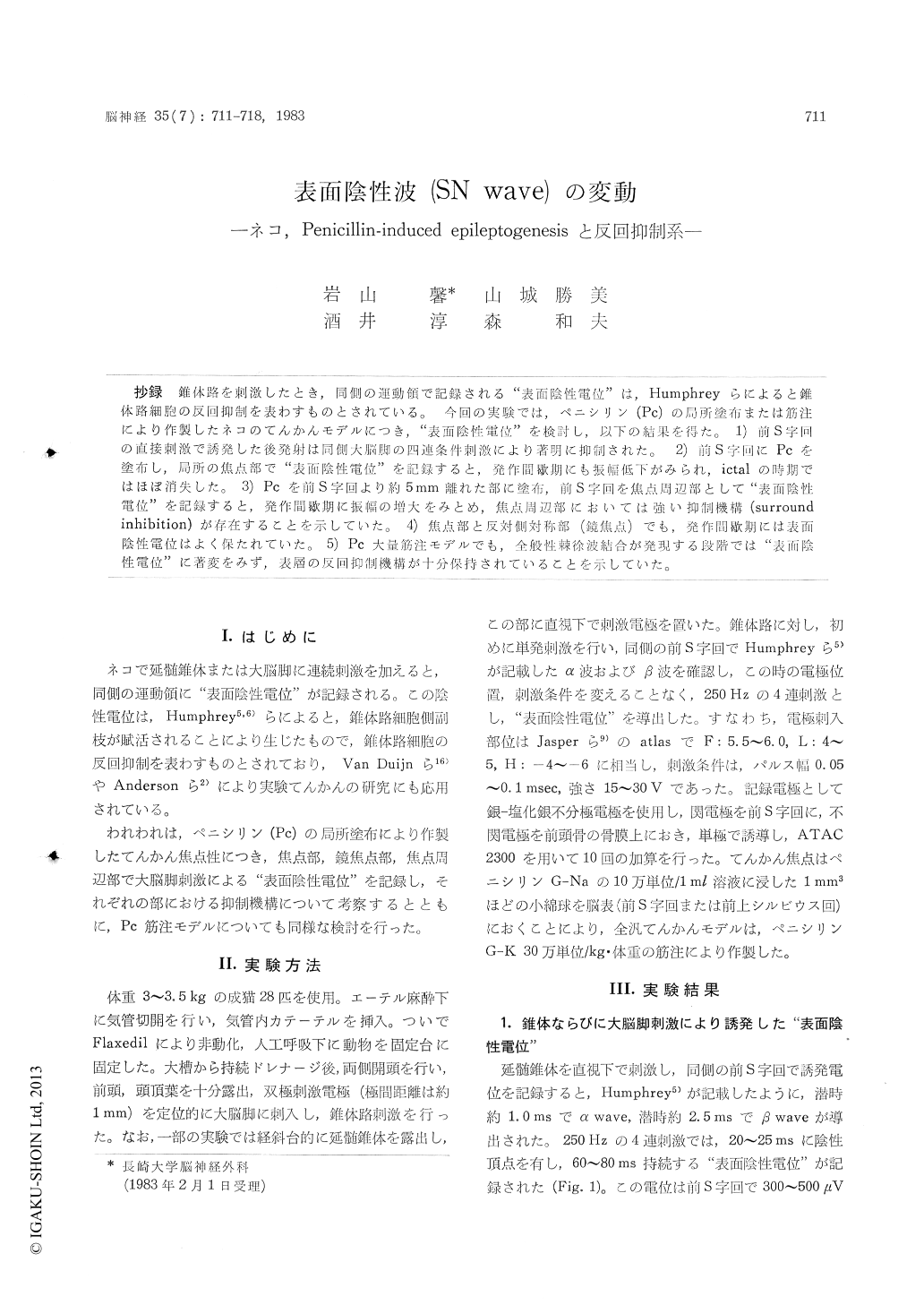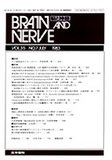Japanese
English
- 有料閲覧
- Abstract 文献概要
- 1ページ目 Look Inside
抄録 錐体路を刺激したとき,同側の運動領で記録される"表面陰性電位"は,Humphreyらによると錐体路細胞の反回抑制を表わすものとされている。今回の実験では,ペニシリン(Pc)の局所塗布または筋注により作製したネコのてんかんモデルにつき,"表面陰性電位"を検討し,以下の結果を得た。1)前S字回の直接刺激で誘発した後発射は同側大脳脚の四連条件刺激により著明に抑制された。2)前S字回にPcを塗布し,局所の焦点部で"表面陰性電位"を記録すると,発作間歇期にも振幅低下がみられ,ictalの時期ではほぼ消失した。3) Pcを前S字回より約5mm離れた部に塗布,前S字回を焦点周辺部として"表面陰性電位"を記録すると,発作間歓期に振幅の増大をみとめ,焦点周辺部においては強い抑制機構(surroundinhibition)が存在することを示していた。4)焦点部と反対側対称部(鏡焦点)でも,発作間歇期には表面陰性電位はよく保たれていた。5) Pc大量筋注モデルでも,全般性棘徐波結合が発現する段階では"表面陰性電位"に著変をみず,表層の反回抑制機構が十分保持されていることを示していた。
The "surface negative (SN) wave" produced by pyramidal tract stimulation and recorded at the cortical surface has been identified as a reflection of postsynaptic potentials generated through recurrent inhibitory pathways (Humphrey, et al.). We studied changes in SN wave in an attempt to examine inhibitory mechanisms underlying epile-ptogenesis in immobilized cats.
1) A single shock applied to the cerebral peduncle evoked a and '8 wave at the surface of ipsilateral anterior sigmoid gyrus (Fig.1 A). A train of 4 shocks with 4 msec shock-interval elicited SN wave which had a peak latency of 20 msec and decayed in 60-80 msec (Fig. 1 B, C, D).
2) The spindle-like after-discharges elicited by direct cortical shock were markedly suppressed with conditioning stimulation of the ipsilateral pyramidal tract (Fig. 2). Spike-and-wave com-plexes and other ECoG paroxysms produced by intramuscular administration of penicillin (Pc) were also depressed by repeated stimulation of the cerebral peduncle (Fig. 3). These facts reveal. ed that the inhibitory effects of pyramidal tract stimulation caused to suppress the occurrence of epileptic discharges.
3) SN wave gradually diminished in amplitude after topical application of Pc at the anterior sigmoid gyrus (Fig. 4 A-D). It disappeared com-pletely when tonic-clonic sustained paroxysms occurred at the focus (Fig. 4 E). These effects are due presumably to depression of recurrent post-synaptic inhibition caused by topical penicillin.
4) SN wave observed at the contralateral secondary focus was almost unchanged during interictal and ictal stage (Fig. 5). Even at the stage in which ECoG revealed sustained paro-xysms, recurrent inhibition might well be preserv-ed at the secondary (so-called mirror) focus.
5) Too much interesting was the fact that the amplitude of SN wave at the surrounding focus increased temporally and disappeared during ictal episode (Fig. 6). This data might be correspond-ing to the "surround inhibition" of Prince whopostulated the mechanisms which were active to keep epileptiform activity localized and prevent the transition of interictal into ictal discharge.
6) It was not so rare to observe self-sustained tonic-clonic paroxysms after intramuscular injec-tion of large dose of Pc. SN wave at the stage of spike-and-wave complex was essentially unaffected in amplitude and wave form, but disappearedduring tonic-clonic ictal events (Fig. 7). These data, together with results mentioned at 2), demon-strated that recurrent inhibition might also be preserved on the model of feline generalized penicillin epilepsy (FGPE) as has been reported by Gloor et al.

Copyright © 1983, Igaku-Shoin Ltd. All rights reserved.


